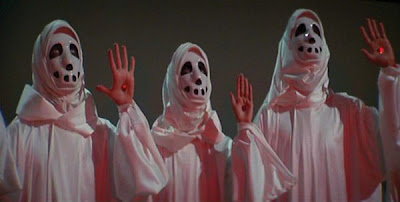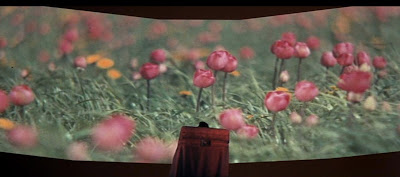I've been devoting considerable space here lately to science fiction cinema's unforgettable dystopias; those dark worlds of the imagination in which mankind takes a wrong turn on the road to a better future.
These memorable and often haunting films dwell on such matters as overpopulation, food shortages, eugenics, and collectivist societies that snuff out all individuality and even humanity.
We've had great dystopian movies with us now for many decades. In the 1960s we saw The Tenth Victim (1965) and Fahrenheit 451 (1966). In the 1980s we saw Blade Runner (1982) and The Running Man (1987). And recent decades have brought us such fare as Gattaca (1997), Minority Report (2002), Gamer (2009) and Surrogates (2009).
But the Great Age of Film Dystopias is unquestionably the 1970s; our nation's very own "crisis of confidence" decade. The Energy Crisis, Watergate, the Vietnam War, the Manson Family, Three Mile Island, Roe vs. Wade and the Iran hostage situation all became part of our national dialogue in what I often term the disco-decade.
In terms of film history, those years between 1970 and 1979 also gave the world THX-1138 (1971), Z.P.G. Zero Population Growth (1972), Soylent Green (1973), Zardoz (1974), Death Race 2000 (1975), Logan's Run (1976) and many other examples of the genre.
In the days ahead, I hope to lay my hands on such harder-to-find dystopian efforts such as The Last Child (A 1970s TV movie), Amerika (a 1987 TV miniseries about a Soviet-takeover of the United States) and the grand-daddy of such dystopian imaginings, the not-currently-available-on-DVD 1984 (1984), an adaptation of Orwell's seminal literary work.
But before we get to such movie reviews, I wanted to pause here and acknowledge some of the qualities that make these cinematic speculations about our future so intriguing, and often so frightening.
I looked back across my postings and saw that almost every 1970s film about dystopian futures shares one element in common. All these films feature governments or other systems of control that turn human against human; man against his brother. And they each do so, universally, utilizing some kind of futuristic technology or futuristic application of technology.
These films might thus be viewed as speculative endeavors and also as warnings about the shape of things to come; of future science or technology "run amok." In all these future societies listed below, the government has created a new social "ritual" (a continental race, a form of legally-sanctioned punishment, a religious service, a public service, etc.) that actually runs counter to all that moral human beings currently hold dear.
So without further description, here are The Five Most De-Humanizing Rituals of 1970s Dystopian Cinema, by my assessment.
5. THX Visits A Unichapel in THX-1138 (1971).
In the future world of THX-1138, the act of going to Church and sharing worship with a community has been deliberately subverted by the government.
Single-serving Unichapel kiosks instead service the worship needs of a vast subterranean city's population. Although decorated with images of Jesus Christ, these unichapels offer platitudes and "Blessings of the Masses" rather than legitimate spiritual guidance.
In fact, the Unichapels serve as a surveillance tool for the State because here citizens can unload all of their secrets, and thus Big Brother learns of them. Off your drugs? Falling in love with your roommate? Now the State knows it all.
The Unichapel confession is so upsetting and de-humanizing a ritual, in my opinion, because it turns the focus of religion away from the needs and aspiration of a community (and doing good deeds) to a more selfish plateau. The Unichapel sits just one. There's no room for the community in it. Worse, in adopting the "confessional" approach, the Unichapel actively turns penitents into informants. And worst, those informants may actually be testifying against themselves.
4.) Make Thy Neighbor Suffer: ZPG Zero Population Growth (1972).
Happen to know anyone in the neighborhood who may be in violation of the World Deliberation Council's Zero Birth Edict?
Well, if so, just telephone the police force and it'll send a futuristic helicopter over to drop an air-tight inflatable tent over the violators (usually a Mother, father and infant)!
Trapped in the death tent, these nasty law-breakers will expire of asphyxiation over the next 24 hours, and you get to see it close-up since the tent is transparent! Another bonus: for doing your civic duty, the State provides you extra food rations.
Again, the idea here is of a neighbor being turned into a "rat" to squeal on his or her neighbors. The State not only encourages such spying and informing, it provides incentive in the form of rations. Perhaps even more disturbing is the notion that an (illegal) child or infant could be punished for his very existence. Like many dystopian ovelords, the State in ZPG wants people numb to the idea of killing for a so-called "common good."
Once more, something immoral (the murder of families...) is ritualized; part of the legal law-enforcement process; and a duty of every citizen.
3.) The Trans-continental race: Death Race 2000 (1975).
In the year 2000, in the United Provinces of America, the President decrees that the trans-continental race is "the American way of life," "no-holds barred."
But drivers in this race compete to become the new American champion by running down innocent pedestrians. They do so explicitly for points. A female pedestrian is worth 10 points, a teenager is worth 40 points, children under 12 are worth 70, and senior citizens carry a whopping 100 points.
So, around the country, TV viewers watch with blood-thirsty glee as their fellow citizens are run down by the death racers. This set-up is no doubt meant by the filmmakers as the equivalent of gladiatorial games and Roman bread and circuses. While the President luxuriates in foreign palaces and the American economy stumbles after the "Crash of 79," the public is distacted by bloody road games. The Running Man is a variation on this theme as well.
But think about it: a favorite weekly TV show is nothing if not a "ritual," and the bloody ritual of the cross-continent "death" race is essentially murder as entertainment; as must-see TV. Life is supposed to be precious, but viewers of the race are meant to cheer when their race runs over a team of doctors, or an old lady. How de-humanizing is that?
2.) "Going Home:" Soylent Green (1973).
In the overpopulated, undernourished city of New York in 2020 (where 20 million people are unemployed), you can have privacy and anything else you desire...but you have to die to get it.
In particular, government centers (called sleep shops in the literary version of the material) euthanize the citizenry.
But hey -- before you die, you can live like a king, able to enjoy you favorite music and a montage of lovely images. It's like Sarah Palin's Death Panels meets an IMAX theater. Who wouldn't want to enjoy that? At least once...
Again, in order to solve desperate problems (food shortages and overpopulation), the State has devoted itself to the death of its very citizenry. It's highly disturbing to think that the only way to enjoy life's pleasures in this future world is to embrace death. And death by sleep shop is a sanctioned ritual of this future world.
1.) "Carousel:" Logan's Run (1975).
 In the shopping-mall, sex-on-demand, plastic-surgery-on-demand 23rd century of Logan's Run, you can have anything your heart desires...except your thirtieth birthday.
In the shopping-mall, sex-on-demand, plastic-surgery-on-demand 23rd century of Logan's Run, you can have anything your heart desires...except your thirtieth birthday. On your "LastDay," by order of the computer that runs the City of Domes, all would-be-30-year olds must report for "Carousel."
And what is Carousel? On the surface, it appears to be a joyous religious ritual in which the old folks compete for re-birth or "renewal" by floating to the top of the heap in a weird gravity pool with glowing lights. In reality, the assembled citizenry of the city watch and cheer in the stadium as Last Day participants are disintegrated by ceiling-mounted laser devices.
Again, Carousel represents the most hideous and de-humanizing idea of this dystopia. It is state-mandated murder (or population control), but Carousel is even more immoral than the sleep shops of Soylent Green, because it masquerades as a mystical, religious tradition. Thus citizens are uninformed, and believed they are witnessing re-incarnation, not disintegration. Here, it's the deception that is so ugly. The State has made a religious ritual out of population control, and the people are so ignorant that they cheer for death.
Of course, in the case of Logan's Run, at least there's the Love Shop (and lots and lots of sex...) before you have to die young.
Your mileage may vary on these cinematic dystopias, but which of these 1970s worlds do you believe offers the most de-humanizing ritual, and why?









Well that last one has to be the creepiest in my book.
ReplyDeleteHi Shannon,
ReplyDeleteI can't argue with you on that. Carousel is one creepy ritual, with those deaths-head masks, "fire"-adorned robes...and distinegrating lasers...
Thanks for the comment!
best,
JKM